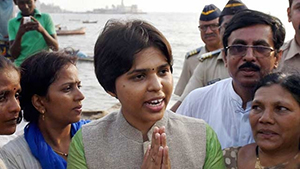Bengaluru, Jan 15: Srishti Institute of Art, Design and Technology in Bengaluru has decided to remain shut for two days after a group of BJP workers wiped out graffiti on its outer walls claiming it as anti-Modi and allegedly warned them against any anti CAA agitation there.
According to sources, the group led by Yelahanka MLA S R Vishwanath allegedly even towed away some vehicles of students and faculty parked in front of the institute alleging that they were blocking the road and causing inconvenience to the local people.
Some students have alleged that they were threatened by BJP workers and also the institute's authorities regarding the graffiti and the blocking of the road using traffic police.
They even claimed that BJP workers warned them against organising any anti-NRC or CAA protests.
A few local residents are also said to have joined the BJP workers and raised complaints about the conduct of the institute's students.
According to local BJP workers, the MLA and a few party men had gone near the institute on receiving complaints from locals about vehicles parked there blocking the road, and when they came across the graffiti they painted it with saffron paint to avoid any controversy, and there was no altercation as being alleged.
However, there is no clarity on who drew the graffiti regarding Modi, which according to BJP workers allegedly depicted the PM in poor light.
The institute has declared holiday on Thursday and Friday to avoid any further escalation, keeping the interest and safety of students in mind, sources said.
Interestingly, on Tuesday graffiti had appeared overnight on the shutters of some shops and walls on the Church Street against Modi, CAA and NRC, following which the city police have launched an investigation.





Comments
It is not a big deal....in Darga you wont find any God.....LOL...
Temple or dargah both are same which leads to shirk..... both believers of temple and dargah has lack of religious knowledge, instead of reading their religious books this people are believing this fraud baba, tantrik, swami, tangal, koya etc.... may Allah give hidaya to all the human beings in this earth to know the truth
I am sure that Trupti Desai is doing such unwanted acts only to get popularity. Is she really concerned about women, she should fight agaisnt dowry, killings of woman in the name of dowry, rape, misbehave by immoral police etc etc. In the same time, Desai should know that Dargah is not a holy place for Muslims and there is no need of any Muslim to pray in the Dargah. Muslim women are given freedom to pray in their home. Instead of praying at home why are they so eager to visit Dargah or Masjid. Does they want to show their beauty? why are they interested in unnecessary activities which is being supported by Desai whereas she is not interested in actual and important things. Does Desai has no other job?
Think Brothers Think ... and PONDER, is DARGAH culture allowed in ISLAM? Y are we encouraging this system of worship... which is close to the cultures of pagan worshipers...
WORSHIP ALLAH the way Prophet Muhammad pbuh taught us and follow the Sahabas RA .. When U follow the last and final prophet of ALLAH, U will not be trapped with such humiliation. When we follow our own desire... then expect such treatment ...
Prayer of the Mushriks.. There is no Darga concept in islam.
Dear Desai,
Just for your information it is one and the same, if you pray in darga or in temple it will go nowhere. worship the creator not his creation.
Add new comment